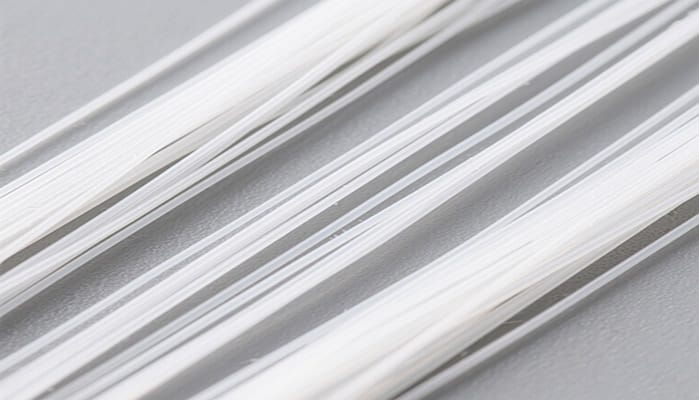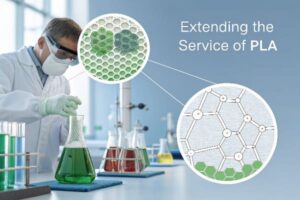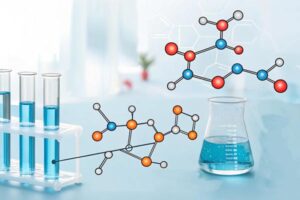Polyester monofilaments are being used more and more in industries like textiles, packaging, geotechnical engineering, and automotive. This expansion brings with it intense competition and new challenges. Polyester producers are under increasing pressure due to overcapacity and product homogeneity.
Hydrolytic degradation is a critical performance issue, particularly under high temperature and humidity. Traditional polyester monofilaments are prone to chain scission due to hydrolysis, resulting in reduced mechanical strength, discoloration, and a shortened lifespan—significantly limiting their competitiveness in high-value applications such as automotive interiors, outdoor fabrics, and solar panels.
Carbodiimide-based anti-hydrolysis agents (CDI) are gaining popularity as a solution for improving the durability, processability, and sustainability of polyester monofilaments. This allows manufacturers to move into higher-value markets.
see more about what is anti-hydrolysis agent?
Mechanisms and Benefits of Carbodiimide Antihydrolysis Additives
Carbodiimide additives react selectively with carboxyl groups (–COOH) on polyester or nylon polymer chains. These additives block the hydrolysis chain reaction by capping hydrolytically sensitive end groups. This significantly improves long-term stability in hot and humid environments.
In practice, incorporating 0.5% to 2% CDI can extend the hydrolytic lifespan of polyester monofilaments by 2 to 5 times. For instance, modified monofilaments can retain over 90% of their mechanical strength even at 85°C and 85% relative humidity. This makes them ideal for high-performance applications such as automotive components, technical textiles, and construction geotextiles.
CDI products such as HyMax 1010 show excellent dispersibility in polyesters, polyurethanes, hot-melt adhesives, and coatings—reducing viscosity shifts and minimizing processing defects like discoloration or gel formation.
Six Strategies to Strengthen Polyester Monofilament Competitiveness
- Technical Upgrades: Optimized Formulation Integration
CDI effectiveness depends on dosage, dispersion, and processing. Manufacturers should customize concentrations—1.5%-3% for automotive uses, 0.5%-1% for general textile-grade monofilaments. For even distribution, twin-screw extrusion and masterbatch formats are recommended.
A leading textile firm extended the outdoor service life of its monofilament-based performance fabrics from 2 to 8 years using CDI additives—greatly enhancing its position in premium EU/US markets. - Product Differentiation – Develop Functional and Eco-Friendly Monofilaments
Smart and functional applications are replacing traditional uses. Combining CDI with additives like UV stabilizers, antimicrobials, or elasticity enhancers allows for high-performance monofilaments suited to healthcare, protective gear, and wearable tech.
Blending with biodegradable resins like PLA or PBS helps create durable yet compostable materials that meet both performance and carbon neutrality goals. - Telling the ‘Durable & Green Tech’ Story: Branding and Market Positioning
Target B2B sectors like aerospace, renewable energy, and automotive with long-lasting monofilament solutions. On the B2C side, leverage platforms like Instagram or TikTok to promote “anti-hydrolysis” materials with sustainability messaging.
For example, a Chinese materials company successfully entered the Middle East market by co-developing a CDI monofilament-based waterproof membrane with a downstream partner and securing green certifications. - Cost-Effective Masterbatch Solutions: Value Chain Collaboration
Masterbatch formats of CDI enable precise dosing, minimize waste, and enhance batch consistency. Close upstream-downstream collaboration via joint R&D and tech services supports faster go-to-market and better responsiveness to customer needs. - Geographic Focus: Leverage APAC Growth Opportunities
Asia-Pacific—especially China, India, and Vietnam—remains a key growth region. From 2024 to 2030, APAC’s polyester monofilament market is projected to grow over 8.5%. Rising demand for recycled and eco-certified materials presents strong prospects for performance-driven, sustainable monofilament products. - Future Perspective: Multifunctionality and Nano Integration
Next-gen CDI additives will combine hydrolysis resistance with flame retardancy, UV protection, and antimicrobial functionality. Emerging technologies like nanocoatings and interface modification aim to boost performance and enable fiber-level control.
Conclusion – Anti-Hydrolysis: The Starting Point for Upgrading Polyester Monofilaments
In today’s market, price alone isn’t enough. Manufacturers must raise their game across branding, performance, cost-efficiency, and regional expansion. CDI-based anti-hydrolysis solutions offer a concrete path to longer-lasting, higher-value monofilament products.
It’s not just about resisting degradation—it’s about enabling a future of stronger, greener, and more competitive polyester monofilaments.
Need samples, formulation guidance, or market insights?
Contact our technical advisors today.
Let’s make polyester monofilaments tougher, greener, and more competitive—together.







